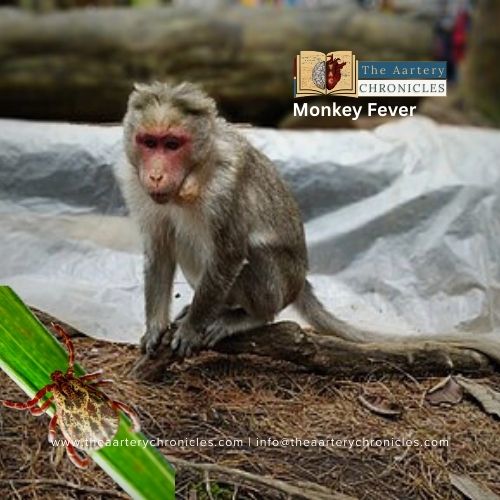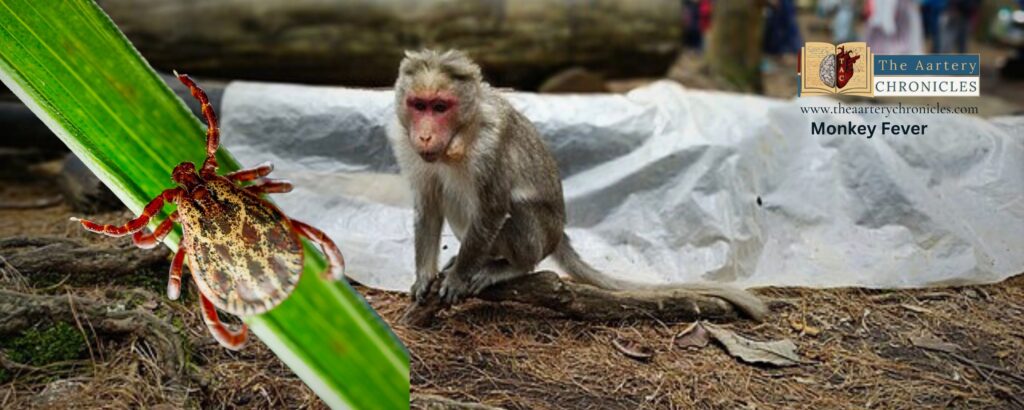

Kyasanur Forest Disease (KFD): The Enigma of Monkey Fever
Overview: Kyasanur Forest Disease (KFD) or Monkey Fever
Kyasanur Forest Disease (KFD), commonly known as “Monkey Fever,” is a viral hemorrhagic fever endemic to South Asia, particularly in the western Ghats of India. The disease is transmitted by ticks. carrying the Kyasanur Forest Disease Virus (KFDV), a member of the Flaviviridae virus family. First discovered in 1957 in Karnataka’s Kyasanur Forest, the disease’s name is derived from its place of origin. It presents with symptoms ranging from fever and headache to severe hemorrhagic signs, with a fatality rate between 3 and 5%
Epidemiology of Kyasanur Forest Disease (KFD)
Initially confined to the Karnataka region of Shimoga, Kyasanur Forest Disease (KFD) has expanded its geographical reach to include states such as Kerala, Tamil Nadu, and Goa. Seasonal outbreaks are observed when nymphal tick activity peaks, typically occurring from December to May.
Mode of Transmission for Kyasanur Forest Disease (KFD)
The primary mode of transmission is through the bite of an infected tick. However, secondary transmission can occur through contact with the blood or tissues of an infected animal. Notably, monkeys, particularly the bonnet macaque and black-faced langur, experience a high mortality rate due to the disease.
Signs and Symptoms of Kyasanur Forest Disease (KFD)
The onset of Kyasanur Forest Disease (KFD) is marked by initial signs such as headache, fever, and chills, typically appearing three to eight days after exposure. As the disease progresses, severe muscle pain, vomiting, gastrointestinal complaints, and bleeding complications may manifest three to four days into the illness. Patients often exhibit low platelet, red blood cell, and white blood cell counts, coupled with abnormally low blood pressure.
While many recover within 1–2 weeks without complications, some individuals may experience neurological manifestations which may include:
- Excruciating headache
- Disorientation
- Visual impairments
- Tremors and shaking
Risk of Exposure to Kyasanur Forest Disease (KFD)
Individuals engaged in the forest industry, hunting, herding, or those exposed to rural or outdoor environments are at risk of infection through contact with infected ticks. The seasonality of the disease, with prevalence noted from November to June, may constitute a significant risk factor, although there is currently no conclusive evidence confirming this pattern.
Diagnosis of Kyasanur Forest Disease (KFD)
Diagnosing Kyasanur Forest Disease (KFD) can be challenging initially due to its vague initial symptoms.
- Molecular detection via polymerase chain reaction (PCR) or virus isolation from blood can help identify the stages of the illness.
- Laboratory confirmation is often obtained through serological assays, including ELISA for IgM and IgG antibodies, RT-PCR for viral RNA detection in blood and tissue samples, and virus isolation in cell cultures.
Treatment and Prevention of Kyasanur Forest Disease (KFD)
For KFD, there is no antiviral medication exists, making supportive therapy and early hospitalization critical. Individuals with bleeding issues should prioritize fluid intake and adhere to standard safety measures while receiving treatment for secondary infections.
As a preventive measure, Vaccination is advised for high-risk groups in endemic areas. the KFD vaccine requires booster doses to maintain immunity. Important elements of KFD prevention include
- Ecological management techniques to reduce tick populations
- Community Education
- Personal protective measures against tick bites such as Wearing protective gear in locations where ticks are endemic and using insect repellents.

Author: Sanika Pande
- Medicine and Diseases
- Nutrition and Diet
Lorem ipsum dolor sit amet, consectetur adipiscing elit. Ut elit tellus, luctus nec ullamcorper mattis, pulvinar dapibus leo.
















